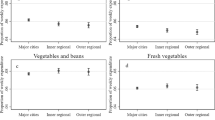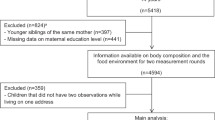Abstract
Background/Objectives:
Living in socioeconomically disadvantaged neighbourhoods is associated with increased risk of a poor diet; however, the mechanisms underlying associations are not well understood. This study investigated whether selected healthy and unhealthy dietary behaviours are patterned by neighbourhood-socioeconomic disadvantage, and if so, whether features of the neighbourhood–nutrition environment explain these associations.
Subjects/Methods:
A survey was completed by 1399 women from 45 neighbourhoods of varying levels of socioeconomic disadvantage in Melbourne, Australia. Survey data on fruit, vegetable and fast-food consumption were linked with data on food store locations (supermarket, greengrocer and fast-food store density and proximity) and within-store factors (in-store data on price and availability for supermarkets and greengrocers) obtained through objective audits. Multilevel regression analyses were used to examine associations of neighbourhood disadvantage with fruit, vegetable and fast-food consumption, and to test whether nutrition environment factors mediated these associations.
Results:
After controlling for individual-level demographic and socioeconomic factors, neighbourhood disadvantage was associated with less vegetable consumption and more fast-food consumption, but not with fruit consumption. Some nutrition environmental factors were associated with both neighbourhood disadvantage and with diet. Nutrition environmental features did not mediate neighbourhood-disadvantage variations in vegetable or fast-food consumption.
Conclusions:
Although we found poorer diets among women living in disadvantaged neighbourhoods in Melbourne, the differences were not attributable to less supportive nutrition environments in these neighbourhoods.
This is a preview of subscription content, access via your institution
Access options
Subscribe to this journal
Receive 12 print issues and online access
$259.00 per year
only $21.58 per issue
Buy this article
- Purchase on Springer Link
- Instant access to full article PDF
Prices may be subject to local taxes which are calculated during checkout
Similar content being viewed by others
References
Andreyeva T, Blumenthal DM, Schwartz MB, Long MW, Brownell KD (2008). Availability and prices of foods across stores and neighborhoods: the case of New Haven, Connecticut. Health Affairs 27, 1381–1388.
Australian Bureau of Statistics (2003). Census of Population and Housing: Socio-Economic Indexes for Areas (SEIFA). Australian Bureau of Statistics: Canberra.
Ball K, Crawford D, Mishra G (2006). Socio-economic inequalities in women's fruit and vegetable intakes: a multilevel study of individual, social and environmental mediators. Public Health Nutr 9, 623–630.
Ball K, Jeffery RW, Crawford DA, Roberts RJ, Salmon J, Timperio AF (2008). Mismatch between perceived and objective measures of physical activity environments. Prev Med 47, 294–298.
Ball K, Timperio A, Crawford D (2009). Neighbourhood socioeconomic inequalities in food access and affordability. Health Place 15, 578–585.
Baron RM, Kenny DA (1986). The moderator–mediator variable distinction in social psychological research: conceptual, strategic, and statistical considerations. J Pers Soc Psychol 51, 1173–1182.
Buijsse B, Feskens EJ, Schulze MB, Forouhi NG, Wareham NJ, Sharp S et al (2009). Fruit and vegetable intakes and subsequent changes in body weight in European populations: results from the project on Diet, Obesity, and Genes (DiOGenes). Am J Clin Nutr 90, 202–209.
Cade J, Thompson R, Burley V, Warm D (2002). Development, validation and utilisation of food-frequency questionnaires—a review. Public Health Nutr 5, 567–587.
Cairns S (1995). Travel for food shopping: The Fourth Solution. Traffic Eng Control 36, 411–418.
Cerin E, Mackinnon DP (2009). A commentary on current practice in mediating variable analyses in behavioural nutrition and physical activity. Public Health Nutr 12, 1182–1188.
Crockett EG, Clancy KL, Bowering J (1992). Comparing the cost of a Thrifty Food Plan market basket in three areas of New York State. J Nutr Educ 24, 71–78.
Cummins S, Macintyre S (2002). A systematic study of an urban foodscape: the price and availability of food in Greater Glasgow. Urban Stud 39, 2115–2130.
Cummins SC, McKay L, Macintyre S (2005). McDonald's restaurants and neighborhood deprivation in Scotland and England. Am J Prev Med 29, 308–310.
Ecob R, Macintyre S (2000). Small area variations in health related behaviours; do these depend on the behaviour itself, its measurement, or on personal characteristics? Health Place 6, 261–274.
Franco M, Diez Roux AV, Glass TA, Caballero B, Brancati FL (2008). Neighborhood characteristics and availability of healthy foods in Baltimore. Am J Prev Med 35, 561–567.
Giskes K, Turrell G, van Lenthe FJ, Brug J, Mackenbach JP (2006). A multilevel study of socio-economic inequalities in food choice behaviour and dietary intake among the Dutch population: the GLOBE study. Public Health Nutr 9, 75–83.
Giskes K, Van Lenthe FJ, Brug J, Mackenbach JP, Turrell G (2007). Socioeconomic inequalities in food purchasing: the contribution of respondent-perceived and actual (objectively measured) price and availability of foods. Prev Med 45, 41–48.
Glanz K, Basil M, Maibach E, Goldberg J, Snyder D (1998). Why Americans eat what they do: taste, nutrition, cost, convenience, and weight control concerns as influences on food consumption. J Am Diet Assoc 98, 1118–1126.
Glanz K, Sallis JF, Saelens BE, Frank LD (2005). Healthy nutrition environments: concepts and measures. Am J Health Promot 19, 330–333.
Guthrie JF, Lin BH, Frazao E (2002). Role of food prepared away from home in the American diet, 1977–78 versus 1994–96: changes and consequences. J Nutr Educ Behav 34, 140–150.
Latham J, Moffat T (2007). Determinants of variation in food cost and availability in two socioeconomically contrasting neighbourhoods of Hamilton, Ontario, Canada. Health Place 13, 273–287.
Magarey A, McKean S, Daniels L (2006). Evaluation of fruit and vegetable intakes of Australian adults: the National Nutrition Survey 1995. Aust NZ J Public Health 30, 32–37.
Moore LV, Diez Roux AV, Nettleton JA, Jacobs Jr DR (2008). Associations of the local food environment with diet quality—a comparison of assessments based on surveys and geographic information systems: the multi-ethnic study of atherosclerosis. Am J Epidemiol 167, 917–924.
Ness AR, Powles JW (1997). Fruit and vegetables, and cardiovascular disease: a review. Int J Epidemiol 26, 1–13.
Pearce J, Blakely T, Witten K, Bartie P (2007). Neighborhood deprivation and access to fast-food retailing: a national study. Am J Prev Med 32, 375–382.
Pearce J, Day P, Witten K (2008). Neighbourhood provision of food and alcohol retailing and social deprivation in urban New Zealand. Urban Pol Res 26, 213–227.
Pereira MA, Kartashov AI, Ebbeling CB, Van Horn L, Slattery ML, Jacobs Jr DR et al (2005). Fast-food habits, weight gain, and insulin resistance (the CARDIA study): 15-year prospective analysis. Lancet 365, 36–42.
Powell LM, Zhao Z, Wang Y (2009). Food prices and fruit and vegetable consumption among young American adults. Health Place 15, 1064–1070.
Roos E, Talala K, Laaksonen M, Helakorpi S, Rahkonen O, Uutela A et al (2008). Trends of socioeconomic differences in daily vegetable consumption, 1979–2002. Eur J Clin Nutr 62, 823–833.
Shohaimi S, Welch A, Bingham S, Luben R, Day N, Wareham N et al (2004). Residential area deprivation predicts fruit and vegetable consumption independently of individual educational level and occupational social class: a cross sectional population study in the Norfolk cohort of the European Prospective Investigation into Cancer (EPIC-Norfolk). J Epidemiol Commun Health 58, 686–691.
Sooman A, Macintyre S, Anderson A (1993). Scotland's health—a more difficult challenge for some? The price and availability of healthy foods in socially contrasting localities in the west of Scotland. Health Bull (Edinb) 51, 276–284.
Subar AF, Heimendinger J, Patterson BH, Krebs-Smith SM, Pivonka E, Kessler R (1995). Fruit and vegetable intake in the United States: the baseline survey of the Five A Day for Better Health Program. Am J Health Promot 9, 352–360.
Tamers SL, Agurs-Collins T, Dodd KW, Nebeling L (2009). US and France adult fruit and vegetable consumption patterns: an international comparison. Eur J Clin Nutr 63, 11–17.
Thornton LE, Bentley RJ, Kavanagh AM (2009). Fast food purchasing and access to fast food restaurants: a multilevel analysis of VicLANES. Int J Behav Nutr Phys Activ 6, 28.
Turrell G, Giskes K (2008). Socioeconomic disadvantage and the purchase of takeaway food: a multilevel analysis. Appetite 51, 69–81.
Turrell G, Bentley R, Thomas LR, Jolley D, Subramanian S, Kavanagh AM (2009). A multilevel study of area socio-economic status and food purchasing behaviour. Public Health Nutr 12, 2074–2083.
Winkler E, Turrell G, Patterson C (2006). Does living in a disadvantaged area entail limited opportunities to purchase fresh fruit and vegetables in terms of price, availability, and variety? Findings from the Brisbane Food Study. Health Place 12, 741–748.
Xyris Software FoodWorks Professional. Xyris Software: Brisbane, 2007.
Zenk SN, Lachance LL, Schulz AJ, Mentz G, Kannan S, Ridella W (2009). Neighborhood retail food environment and fruit and vegetable intake in a multiethnic urban population. Am J Health Promot 23, 255–264.
Acknowledgements
We are grateful to Rebecca Roberts for assistance with geospatial analyses and Nick Andrianopoulos for advice on the statistical approach. This study was funded by the Australian Research Council (DP0665242) and the National Heart Foundation of Australia (G02M 0658). LT is supported by a National Health and Medical Research Council Capacity Building Grant, ID 425845; KB is supported by a National Health and Medical Research Council Senior Research Fellowship, ID 479513; and D is supported by a VicHealth Research Fellowship.
Author information
Authors and Affiliations
Corresponding author
Ethics declarations
Competing interests
The authors declare no conflict of interest.
Rights and permissions
About this article
Cite this article
Thornton, L., Crawford, D. & Ball, K. Neighbourhood-socioeconomic variation in women's diet: the role of nutrition environments. Eur J Clin Nutr 64, 1423–1432 (2010). https://doi.org/10.1038/ejcn.2010.174
Received:
Revised:
Accepted:
Published:
Issue Date:
DOI: https://doi.org/10.1038/ejcn.2010.174
Keywords
This article is cited by
-
Adult food choices in association with the local retail food environment and food access in resource-poor communities: a scoping review
BMC Public Health (2023)
-
Preferences of women with a vulnerable health status towards nudging for adequate pregnancy preparation as investment in health of future generations: a qualitative study
BMC Pregnancy and Childbirth (2022)
-
Are dietary inequalities among Australian adults changing? a nationally representative analysis of dietary change according to socioeconomic position between 1995 and 2011–13
International Journal of Behavioral Nutrition and Physical Activity (2018)
-
Can big data solve a big problem? Reporting the obesity data landscape in line with the Foresight obesity system map
International Journal of Obesity (2018)
-
Associations between the neighbourhood food environment, neighbourhood socioeconomic status, and diet quality: An observational study
BMC Public Health (2016)



